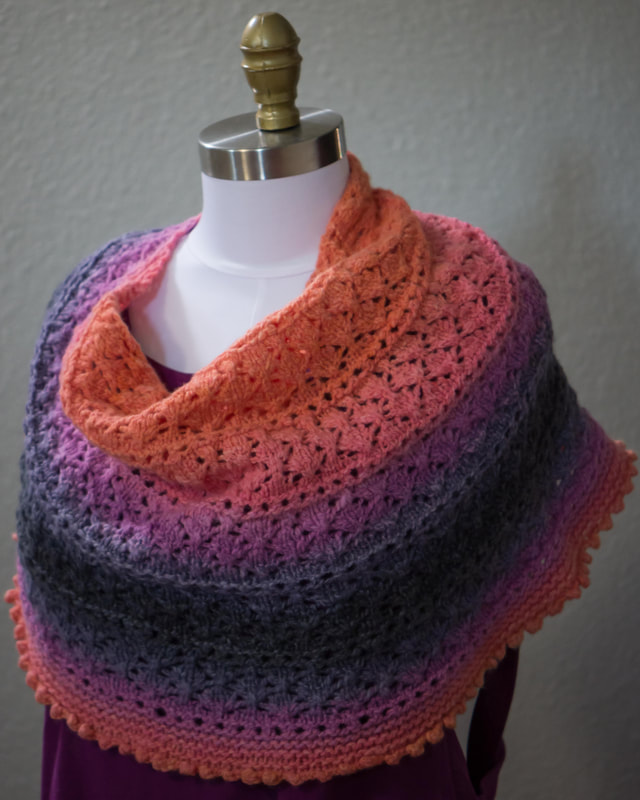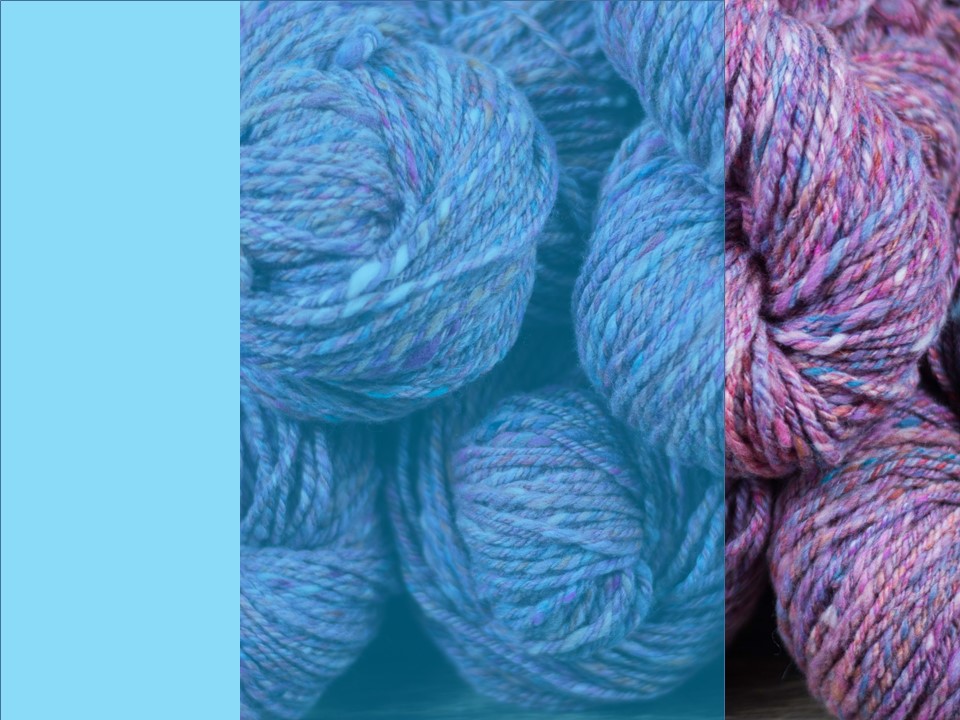|
Here is the fourth episode of the Fiber Sprite Podcast! On this show, I'll talk about projects I've been working on and my visit to the Taos Wool Festival.
Knitting:
Designing:
Spinning:
Weaving:
Books: You know those moments where you think, I have nothing to knit? There usually followed by thoughts of I have no yarn, which is just silly if you've seen the size of my stash. Anyways, that's what happened to me a couple of weeks ago, when I knew there was going to be lots of time spent standing around and waiting. I needed a knitting project that was going to be more engaging than my standard socks, but easy enough that I could carry on a conversation while working on it. Several years ago, I bought the pattern for Starshower, and that's what I cast on with my recently finished Monsoon Sunset spin. I liked that the pattern would preserve the gradient nicely. I liked the shape of the garment, as it drapes in a way that is very similar to how I wear most of my shawls, but without the fuss of having to tie, pin, or worry about the thing coming off. I'm not sure what led me to pair this yarn with that pattern, but I did, and I had a fun project to entertain me in the nick of time. As so often happens with handspun yarn, it wasn't exactly the yarn the pattern called for. My yardage was right, but the gauge I was getting was way too dense for a cowl with some drape. So I ripped back and went up a needle size. I also decided that I wasn't a huge fan of all those slipped stitches, and switched to a lace pattern. Because I do everything the hard way, I essentially re-wrote the pattern to accommodate the lace pattern I liked. (I didn't realize that the designer, Hilary Smith-Calais, has quite a few cowl patterns in similar shapes, some with lovely lace patterns!) The resulting cowl is comfy and cozy and fun, although now it's going to get packed away for the rest of the summer. It's a scorcher over here and our a/c just broke! If you're interested in how I re-wrote the pattern, my Ravelry project page is here, with detailed notes.
Want to spin your own? Monsoon sunset is available in my shop as a 6 oz braid! When it comes to yarn dyeing, there are lots of different techniques. One is "glazing," and it has nothing to do with doughnuts! Glazing is a technique where a dyer applies dye in very thin layers, so that the original color of the yarn is still visible underneath the glaze. It's a lot like the technique of glazing in watercolor painting, where a transparent wash of color is added on top of another color to create more complex fields of colors. There are several different ways to glaze yarn in dyeing, but they all boil down to using small amounts of dye, and making sure the dye strikes on the yarn very quickly. One way to do this is to pre-mordant the yarn, or to make sure there is plenty of acid in the dyebath before adding the dye. Some dyers use dry yarn or yarn that is only slightly damp. This is another way to make sure the dye stays on the outside of the yarn - since it will take some time for the moisture to penetrate to the core of the yarn, the outside of the yarn will be the first to get wet, and therefore the first to absorb the dye. One of the biggest challenges in glazing yarn is predicting what color your yarn will be when it comes out of the dyepot. There's definitely plenty of magic happening there, but a little understanding of color theory can go a long way in deciding what color of glaze you should use. There are plenty of in-depth books and tutorials about color theory, but there's no need to get bogged down in all of that if you don't want to. What you need to know is this:
Knowing what color(s) you're starting with, and what color you're adding in your glaze will help you predict the outcome. But, naturally, I had to take it one step further. Sometimes it's helpful to see a prediction of what the glazed yarn might look like to help avoid disappointment. Here are six samples of predictions of what a recent handspun yarn might look like if I glazed it with blue, purple, pink, orange, turquoise, and black: To create these predictions, I used PowerPoint, though you could use any photo-editing tool that lets you make transparencies. I opened up a picture of my yarn, then drew a rectangle shape over part of the photo. I made sure the shape was selected, then edited it under "format shape." The "fill" section lets you choose the color and the transparency of that color. I usually set the transparency levels to about 50%, and then play around with all the colors I'm thinking of using.
This isn't a perfect prediction - after all, the colors that show up on my monitor aren't going to be the same colors as my dyes, and it would be difficult to get the exact concentration right - but it does give me a good idea of what the glazes will look like, and helps me make more informed choices when I decide to overdye yarn. In this instance, I decided to overdye a leftover skein a blue-purple color. I intend to make a hat and maybe some mitts, and want them to coordinate with my Weekender sweater, but not be too matchy-matchy. Here's the overdyed skein: This year, the spinning group in my guild decided to do a fiber exchange/challenge. The rules were simple: each person would bring in four ounces of clean, unspun fiber, we'd swap it, and make something with it by the end of the year. I got a mystery wool, along with some light tan alpaca. I tossed it all in the dyepot along with some mohair that had been lingering in the stash. Once the wool was dyed, I blended everything on my drum carder, and spun it into fine singles. Then I 3-plied it, resulting in this yarn: The mohair and wool give it a lot of shine, and the alpaca gives it a little bit of softness. Initially, I'd loved the color, but by the time I'd finished, I felt like I'd gotten my fill of that shade of pink.
So, back to the dye pot I went. I used a tye-dye method that I read about in the first issue of Tiny Studio Magazine. The result is a variegated yarn with pink, purples, and oranges. Now to the next part of the challenge - actually making something with the yarn! Spinzilla is a yearly competition to see who can spin the most yarn. There are two categories: teams and "Rogue" spinners. There are winners in each category, based on yardage spun. It's all a friendly competition, and registration fees help fund the TNNA foundation, which helps to educate the public about fiber arts. I wasn't so sure I was going to participate in Spinzilla this year. Last year I signed up to participate, and ended up spinning almost nothing. All the emails asking me to submit my yardage were a little depressing, since I was so disappointed with myself. This year, I knew I was feeling overwhelmed with other commitments, and thought it would be silly to add one more thing to my plate. Naturally, I signed up! As I had done in the past, I chose to sign up as a Rogue spinner. I don't usually participate that much on forums, and there wasn't a team close by, so "going rogue" seemed like the best fit. I decided to be gentle with myself this year. Just spin a little bit in the morning and evening, and don't worry about how much yarn there is at the end. I figured that schedule matched my habits anyways. Plus, I thought it would be interesting to see just how much I could spin in a week without really rushing myself. I often spin for projects over very long periods of time, so using this week's spinning as a baseline for future estimates seemed like a good idea. In the end, I spun 1,708 yards of 2-ply yarn.* Since I don't have many bobbins handy at the moment, I plied as I finished spinning the singles for each colorway. The middle red-orange colorway had one single that was significantly longer than the other, so I plied that with the bits left over after plying on the other colorways, resulting in a few mini-skeins that are slightly different from their "main" color. The fiber is Dorset Horn top from the Woolery, chosen because it was their "special" Spinzilla discount fiber this year. I bought 2 pounds (4 eight-ounce packages), and dyed each one a different color. The two darkest colors are very similar, and then there is a red/orange colorway, and a yellow/orange colorway. There wasn't really a method to the madness when I started dyeing the fiber - I just wanted to use up some pre-mixed dyes that were on the old side! I had a lot of red, orange, and yellow, so that's mostly what I used. The darker shades also have some purple and black in there to get the color to a deep burgundy. I used my guild's spinning wheel, a single-treadle Schacht Matchless, to spin and ply all the yarn. This wheel is really one of my favorites to spin on, since it goes so fast. Lately I've been experimenting with double drive as a tensioning system, and really enjoy that setup. I'm still undecided as to how I'll use this yarn. It's definitely not a soft-next-to-skin sweater yarn, at least for me. In researching the wool, I thought it would be a good rug yarn, and planned to use it in a warp. It might be a little bit sticky for what I had originally envisioned. I've also toyed with the idea of rug punching with it. Once I took the pressure off myself to break records, spinning for Spinzilla this year was really a lot of fun! *Because of the way Spinzilla gives credit for yardage, this is actually 5,124 yards (1,708 yards of single ply, multiplied by two, plus another 1,708 yards of spinning for when they are plied together). That's just under 3 miles of yarn!
|
Archives
January 2024
Categories
All
This website uses marketing and tracking technologies. Opting out of this will opt you out of all cookies, except for those needed to run the website. Note that some products may not work as well without tracking cookies. Opt Out of Cookies |














 RSS Feed
RSS Feed